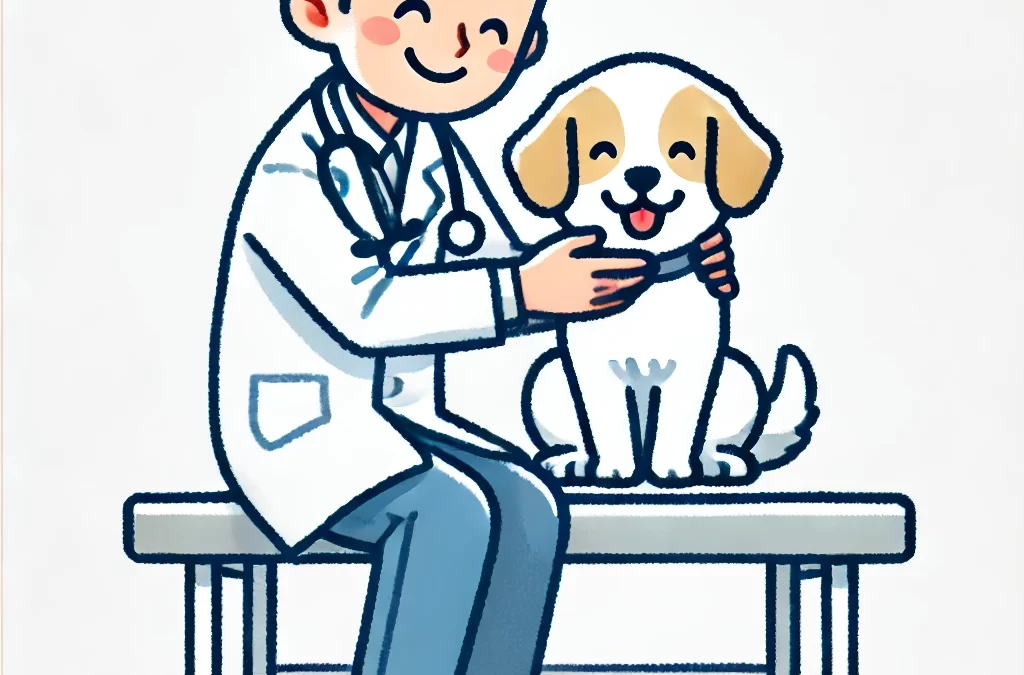
von TCMVET | 30. November 2024 | Krebs und Tumore bei Hunden
Wenn bei einem geliebten Hund Krebs diagnostiziert wird, fühlt es sich an, als ob der Boden unter einem weggebrochen wäre. Doch inmitten der Verzweiflung gibt es auch eine wachsende Bewegung von Tierbesitzern, ganzheitlichen Heilpraktikern und Forschern, die glauben, dass Krebs bei Hunden kein sofortiges Todesurteil sein muss. Mit der richtigen Kombination aus Therapien, Ernährung und Lebensstiländerungen kann das Fortschreiten des Krebses verlangsamt werden, sodass Ihr Hund mehr Zeit hat, das Leben mit Ihnen an seiner Seite zu genießen.
Hier erhalten Sie eine neue Perspektive, wie Sie die Gesundheit Ihres Hundes unterstützen und möglicherweise das Wachstum von Krebszellen verlangsamen können.
1. Denken Sie über die traditionelle Medizin hinaus
Während Chemotherapie und Operation Standardbehandlungen für Krebs bei Hunden sind, suchen viele Tierbesitzer jetzt nach ergänzenden Therapien, die sich auf die Stärkung des Immunsystems und des allgemeinen Wohlbefindens ihres Hundes konzentrieren. Integrative Medizin, die konventionelle Behandlungen mit natürlichen und alternativen Therapien kombiniert, hat in den letzten Jahren an Bedeutung gewonnen.
Therapien wie Akupunktur, Massage und Kräuterbehandlungen können Entzündungen lindern, Schmerzen lindern und die allgemeine Lebensqualität Ihres Hundes verbessern. Vielleicht möchten Sie auch die Welt der Cannabinoide, wie CBD, das in einigen Studien vielversprechende Ergebnisse bei der Schmerzlinderung und der Reduzierung des Tumorwachstums gezeigt hat. Konsultieren Sie immer Ihren Tierarzt, bevor Sie eine alternative Therapie beginnen, aber es ist ermutigend, dass immer mehr Optionen auftauchen.
2. Nutzen Sie die Kraft der Ernährung
Es gibt viel Aufregung um die Vorstellung, dass die Ernährung Ihres Hundes dessen Gesundheit beeinflussen kann – und dazu gehört auch seine Fähigkeit, Krebs zu bekämpfen. Eine krebsunterstützende Ernährung für Ihren Hund geht über die bloße Fütterung mit gesundem Futter hinaus; es geht darum, im Körper eine Umgebung zu schaffen, die es Krebszellen erschwert, zu gedeihen.
Einige Ernährungswissenschaftler empfehlen ketogene Diäten für Hunde mit Krebs, die viel Fett, mäßig viel Eiweiß und wenig Kohlenhydrate enthalten. Diese Art der Ernährung kann den Krebszellen den Zucker entziehen, den sie zum Wachstum benötigen, und so ihr Fortschreiten verlangsamen. Hinzufügen Superfoods gegen Krebs wie Kurkuma, Pilze (Shiitake, Maitake und Reishi) und Grüntee-Extrakt können ebenfalls einen Schub geben.
Lignane, Verbindungen, die in Leinsamen und anderen Pflanzen vorkommen, sollen das Wachstum von Krebszellen bei Hunden verlangsamen, insbesondere bei Hundelymphomen. Sie sollten auch mit Ihrem Tierarzt sprechen über Ergänzungen wie Omega-3-Fettsäuren, Antioxidantien und Vitamin D, die alle eine Rolle bei der Aufrechterhaltung der Immunfunktion und der Unterstützung einer gesunden Zellregeneration spielen.
3. Bewegung und geistige Anregung: Ein Gleichgewicht aus Bewegung und Ruhe
Man könnte meinen, Ihr Hund sollte sich nach der Diagnose Krebs so viel wie möglich ausruhen. Doch genau wie beim Menschen kann ein ausgewogenes Verhältnis von Ruhe und Aktivität dazu beitragen, dass der Körper Ihres Hundes optimal funktioniert. Regelmäßige, leichte Bewegung kann die Durchblutung verbessern, Schmerzen lindern und das Immunsystem Ihres Hundes stärken.
Geistige Anregung ist ebenso wichtig. Wenn Sie den Geist Ihres Hundes mit interaktivem Spielzeug, Trainingseinheiten oder Geruchsspielen beschäftigen, kann dies seine geistige Gesundheit fördern und seine allgemeine Lebenseinstellung verbessern. Ein glücklicherer, weniger gestresster Hund ist wahrscheinlich besser in der Lage, die Herausforderungen zu bewältigen, die Krebs mit sich bringt.
4. Ein ganzheitlicher Ansatz: Die Verbindung von Körper und Geist
Ein Aspekt der Krebsbehandlung, der sowohl bei Menschen als auch bei Haustieren oft übersehen wird, ist die Verbindung zwischen Körper und Geist. Stress und Angst können das Immunsystem schwächen und eine Umgebung schaffen, in der Krebszellen gedeihen können. Daher ist die Förderung einer ruhigen, stressfreien Umgebung für das Wohlbefinden Ihres Hundes unerlässlich.
In Betracht ziehen meditative Praktiken oder schaffen Sie zu Hause einen Zufluchtsort, an dem sich Ihr Hund sicher und entspannt fühlen kann. Dazu können Sie beruhigende Musik spielen, ein gemütliches Bett in einem ruhigen Teil Ihres Zuhauses aufstellen oder sogar eine Aromatherapie mit für Haustiere unbedenklichen ätherischen Ölen durchführen. Dies ist ein kleiner, aber wirkungsvoller Schritt, um sicherzustellen, dass der Körper Ihres Hundes in der bestmöglichen Verfassung ist, um die Krankheit zu bekämpfen.
5. Spitzenforschung und experimentelle Therapien
Wir leben in einer spannenden Zeit, in der die medizinische Forschung zu Krebstherapien rasch voranschreitet. Während sich die Landschaft der Behandlung von Hundekrebs noch weiterentwickelt, gibt es einige faszinierende neue Behandlungen, die vielversprechend sind, wie Immuntherapie Und GentherapieDiese hochmodernen Therapien zielen darauf ab, das körpereigene Immunsystem des Hundes anzuregen, den Krebs wirksamer zu bekämpfen, wobei die Tumore oft präziser angegriffen werden als mit herkömmlichen Methoden.
Bleiben Sie informiert und setzen Sie sich für Ihren Hund ein, indem Sie Spezialisten konsultieren, die über die neuesten Behandlungen und klinischen Studien auf dem Laufenden sind. Möglicherweise können Sie Ihrem Hund Therapien zugänglich machen, die noch nicht allgemein verfügbar sind, um das Fortschreiten des Krebses zu verlangsamen und seine Lebensqualität zu verbessern.
6. Die Kraft der Liebe und des Mitgefühls
Der vielleicht tiefgreifendste und oft unterschätzte Aspekt bei der Behandlung von Krebs bei Hunden ist die heilende Kraft von Liebe und emotionaler Bindung. Ihre Anwesenheit, Aufmerksamkeit und Fürsorge können Ihrem Hund großen Trost spenden und Ängste und Stress abbauen, wodurch sein Immunsystem besser funktionieren kann.
Es geht nicht nur um das Futter, die Medizin oder die Behandlungen – es geht um die Bindung, die Sie teilen. Diese Beziehung gibt Ihrem Hund die Kraft zu kämpfen, die Freude am Leben und das beruhigende Gefühl, dass er zutiefst geliebt wird, egal was passiert.
Fazit: Krebs verlangsamen, Schritt für Schritt
Krebs bei Hunden ist zweifellos verheerend, aber es ist wichtig, daran zu denken, dass es viele Möglichkeiten gibt, das Fortschreiten der Krankheit zu verlangsamen und die Gesundheit Ihres Hundes zu unterstützen. Indem Sie moderne tierärztliche Behandlungen mit alternativen Therapien, richtiger Ernährung, Bewegung und emotionaler Betreuung kombinieren, können Sie die Lebensqualität Ihres Hundes erheblich verbessern.
Der Weg mag lang sein, aber mit einem ganzheitlichen Ansatz und großem Engagement für das Wohlergehen Ihres Hundes können Sie ihm zu einem erfüllteren und glücklicheren Leben verhelfen – einem Leben, in dem nicht der Krebs seine Geschichte bestimmt, sondern die Liebe und Fürsorge, die Sie ihm täglich geben.

von TCMVET | 29. November 2024 | Chinesische Kräutermedizin für Haustiere
Wenn es um natürliche Heilmittel für Hunde geht, ist Lysimachia 3 ein aufsteigender Stern in der ganzheitlichen Veterinärmedizin. Diese Kräuterformel, die in den bewährten Traditionen der Traditionellen Chinesischen Medizin (TCM) verwurzelt ist, gewinnt aufgrund ihrer potenziellen Vorteile bei der Unterstützung der Gesundheit von Hunden an Aufmerksamkeit, insbesondere bei der Behandlung von Blasensteinen, Harnwegsproblemen und Entzündungen. Dieser Artikel wirft eine einzigartige Perspektive darauf, warum Lysimachia 3 der heimliche Held auf dem Weg zur Gesundheit Ihres Hundes sein könnte.
Was ist Lysimachia 3?
Lysimachia 3, in der TCM auch als „Drei-Gelbes Pulver“ bekannt, ist eine Mischung aus drei wirksamen Kräutern:
- Lysimachia (Jin Qian Cao): Bekannt für seine entgiftenden und steinauflösenden Eigenschaften.
- Löwenzahn (Pu Gong Ying): Ein natürliches entzündungshemmendes und harntreibendes Mittel.
- Kochbanane (Che Qian Cao): Unterstützt die Gesundheit der Harnwege und lindert Reizungen.
Diese Dreierkombination aus Kräutern wirkt synergetisch, um die Blasengesundheit zu fördern, Entzündungen zu reduzieren und das allgemeine Wohlbefinden zu steigern.
Warum sollte man Lysimachia 3 für Hunde in Betracht ziehen?
Im Gegensatz zu Arzneimitteln, die sich häufig auf die Symptombehandlung konzentrieren, ist Lysimachia 3 darauf ausgelegt, die Grundursache von Gesundheitsproblemen zu bekämpfen. Dieser Ansatz entspricht einem wachsenden Trend unter Tierbesitzern, die nach natürlichen, sanften und wirksamen Lösungen suchen.
Einzigartige Anwendungen von Lysimachia 3
1. Blasensteine und Kristalle
Lysimachia 3 wird für seine Fähigkeit geschätzt, Blasensteine aufzulösen und die Bildung von Harnkristallen zu verhindern. Seine steinbrechenden Eigenschaften machen es zu einer hervorragenden Alternative für Hunde, die unter wiederkehrenden Harnproblemen leiden.
2. Harnwegsinfektionen
Dank seiner antibakteriellen und entzündungshemmenden Wirkung kann Lysimachia 3 helfen, die Symptome von Harnwegsinfektionen (HWI) zu lindern. Es beruhigt die Harnwege, fördert die Heilung und lindert Beschwerden.
3. Entgiftung
Lysimachia 3 unterstützt Leber und Nieren beim Ausspülen von Giftstoffen. Dies macht es zu einer wertvollen Ergänzung von Entgiftungsprotokollen, insbesondere für Hunde, die Umweltgiften oder Langzeitmedikamenten ausgesetzt sind.
So verwenden Sie Lysimachia 3 sicher für Hunde
- Konsultieren Sie einen Tierarzt: Konsultieren Sie immer einen mit Kräutermedizin vertrauten Tierarzt, bevor Sie Lysimachia 3 verabreichen. Die Dosierung variiert je nach Größe, Gesundheitszustand und spezifischen Bedürfnissen Ihres Hundes.
- Pulver- oder Kapselform: Die Kräuter können als Pulver mit dem Futter vermischt oder bequem in Kapselform verabreicht werden.
- Monitor for Reactions: Obwohl Nebenwirkungen selten sind, sollten Sie bei Ihrem Hund auf Anzeichen von Verdauungsstörungen oder allergischen Reaktionen achten.
Die moderne Renaissance antiker Heilmittel
In einem Zeitalter, in dem synthetische Medikamente dominieren, ist das Wiederaufleben von Kräuterformeln wie Lysimachia 3 ein Beweis für ihren anhaltenden Wert. Die moderne Forschung beginnt zu bestätigen, was alte Heiler seit Jahrhunderten wissen: Die Natur hält wirksame Lösungen für die Gesundheit bereit.
Zum Beispiel:
- Anekdotische Erfolgsgeschichten: Hundebesitzer berichten von deutlichen Verbesserungen der Symptome ihrer Haustiere, von verringerten Harnschmerzen bis hin zur vollständigen Auflösung von Blasensteinen.
- Synergie mit der Schulmedizin: Lysimachia 3 kann traditionelle Behandlungen ergänzen, ihre Wirksamkeit steigern und die Abhängigkeit von Antibiotika verringern.
Wann Sie Lysimachia 3 für Ihren Hund in Betracht ziehen sollten
Lysimachia 3 ist nicht nur für Hunde mit aktiver Blase oder Harnproblemen geeignet. Es kann auch als vorbeugende Maßnahme für Rassen verwendet werden, die für solche Erkrankungen anfällig sind, wie Dalmatiner oder Bulldoggen. Darüber hinaus ist es eine ausgezeichnete Option für Hunde, die sich von einer Blasenoperation oder chronischen Harnwegsinfektionen erholen.
Ist Lysimachia 3 das Richtige für Ihren Hund?
Lysimachia 3 ist eine natürliche, ganzheitliche Option zur Behandlung der Blasen- und Harngesundheit bei Hunden. Die einzigartige Kräutermischung behandelt nicht nur die Symptome, sondern auch die zugrunde liegenden Ursachen und bietet eine umfassende Lösung, die dem Wunsch moderner Tierbesitzer nach natürlicher Pflege entspricht.
Ob Sie nach Alternativen zu Operationen suchen, chronische Probleme behandeln oder einfach die Gesundheit Ihres Hundes verbessern möchten, Lysimachia 3 könnte der pflanzliche Verbündete sein, den Ihr pelziger Begleiter braucht. Mit seiner reichen Geschichte und nachgewiesenen Wirksamkeit rückt dieses alte Heilmittel als moderne Lösung für das Wohlbefinden von Hunden ins Rampenlicht.

von TCMVET | 29. November 2024 | Krebs und Tumore bei Hunden
Angesichts der emotionalen und finanziellen Belastung einer Tumordiagnose bei einem Hund fühlen sich viele Tierbesitzer von den mit der Behandlung verbundenen Kosten überfordert. Eine kostengünstige Tumorentfernung bei Hunden ist jedoch nicht nur möglich, sondern mit den richtigen Mitteln und etwas Kreativität auch realisierbar. Dieser Leitfaden untersucht einzigartige und praktische Möglichkeiten, um sicherzustellen, dass Ihr pelziger Freund die Pflege erhält, die er benötigt, ohne Ihren Geldbeutel zu belasten.
Tumorarten und Notwendigkeit einer Entfernung verstehen
Nicht alle Tumore erfordern einen sofortigen chirurgischen Eingriff. Einige, wie Lipome (gutartige Fettgeschwülste), stellen möglicherweise keine oder nur eine geringe Gefahr für die Gesundheit Ihres Hundes dar. Die Konsultation Ihres Tierarztes zur Beurteilung der Art des Tumors ist der erste Schritt zu einer fundierten Entscheidung. Wenn eine Entfernung als notwendig erachtet wird, prüfen Sie kostengünstige Optionen zur Lösung des Problems.
Kreative Ansätze zur kostengünstigen Tumorentfernung bei Hunden
Veterinärschulen: Lernen und Sparen
Lehrkrankenhäuser für Tiere bieten oft kostengünstigere Leistungen an, da hier Studenten unter Anleitung erfahrener Fachkräfte die Behandlungen durchführen. Die Kosten sind zwar geringer, die Qualität der Behandlung bleibt jedoch hoch, was diese Klinik zu einer ausgezeichneten Option für preisbewusste Tierbesitzer macht.
Gemeinnützige Tierkliniken
Viele gemeinnützige Organisationen und Tierschutzorganisationen bieten subventionierte tierärztliche Versorgung an, einschließlich Tumorentfernung. Informieren Sie sich über Organisationen in Ihrer Nähe, die einkommensschwache Tierhalter unterstützen, wie etwa die Humane Society oder SPCA-Zweigstellen, die möglicherweise finanzielle Hilfe leisten.
Crowdfunding-Plattformen
Auf Plattformen wie GoFundMe oder Waggle können Tierbesitzer die Geschichte ihres Hundes teilen und Geld für medizinische Behandlungen sammeln. Eine gefühlvolle Erzählung und Fotos können Spender dazu ermutigen, zum Wohl Ihres Haustiers beizutragen.
Zahlungspläne mit örtlichen Tierärzten
Einige Tierkliniken bieten Ratenzahlung für teure Operationen an. Mit dieser Option können Sie die Kosten auf mehrere Monate verteilen und so die unmittelbare finanzielle Belastung verringern.
DIY-Wiederherstellung und Nachsorge
Während die Operation selbst immer von einem zugelassenen Tierarzt durchgeführt werden sollte, können Sie Geld sparen, indem Sie die postoperative Pflege zu Hause durchführen. Erfahren Sie, wie Sie Wunden reinigen, Medikamente verabreichen und einen angenehmen Erholungsraum für Ihren Hund schaffen, um zusätzliche Klinikbesuche zu minimieren.
Alternativen erkunden: Wenn eine Operation keine Option ist
Wenn eine Operation Ihre finanziellen Mittel übersteigt oder aufgrund des Gesundheitszustands Ihres Hundes nicht empfohlen wird, können alternative Therapien helfen, den Tumor in den Griff zu bekommen. Einige ganzheitliche Optionen sind:
- Pflanzliche Nahrungsergänzungsmittel: Natürliche Heilmittel wie Kurkuma, Weihrauch und TCM-Rezepturen wie Chuanxiong sind für ihre entzündungshemmenden Eigenschaften bekannt.
- CBD-Öl: Vollspektrum-CBD-Öl kann Entzündungen lindern und das allgemeine Wohlbefinden fördern.
- Ernährungsumstellung: Anti-Krebs-Diäten mit Schwerpunkt auf vollwertigen, kohlenhydratarmen und proteinreichen Lebensmitteln können das Tumorwachstum verlangsamen.
Vorbeugende Maßnahmen zur Vermeidung zukünftiger Kosten
Vorbeugende Maßnahmen können die Wahrscheinlichkeit der Tumorbildung verringern. Regelmäßige tierärztliche Untersuchungen, eine ausgewogene Ernährung und die Vermeidung von Karzinogenen wie Tabakrauch können Ihrem Hund ein gesünderes Leben ermöglichen. Früherkennung ist entscheidend; kleine Tumore sind im Allgemeinen einfacher und kostengünstiger zu behandeln als fortgeschrittene.
Mitgefühl und Einfallsreichtum: Der Schlüssel zu bezahlbarer Pflege
Die Suche nach kostengünstigen Möglichkeiten zur Tumorentfernung bei Hunden erfordert Einfallsreichtum und Entschlossenheit. Indem Sie gemeinnützige Organisationen, die Unterstützung der Gemeinschaft und alternative Therapien nutzen, können Sie sicherstellen, dass Ihr Hund die Pflege erhält, die er braucht, ohne finanzielle Schwierigkeiten zu haben. Denken Sie daran, dass Ihre Kreativität und Liebe zu Ihrem Haustier den Weg für mitfühlende und wirksame Lösungen ebnen können.
Ob Sie nun ein Netzwerk kostengünstiger Pflegeanbieter nutzen oder ganzheitliche Ansätze verfolgen, die Gesundheit Ihres Hundes muss keine unüberwindbaren Kosten verursachen. Lassen Sie uns auf diesem Weg an die unerschütterliche Bindung zwischen Haustieren und ihren Besitzern erinnern – eine Beziehung, die jede Mühe wert ist.

von TCMVET | 28. November 2024 | Krebs und Tumore bei Hunden
Wenn Ihr Hund anfängt zu hinken oder seine Pfoten übermäßig zu lecken, könnte eine Interdigitalzyste die Ursache sein – eine häufige und besorgniserregende Erkrankung. Obwohl diese Zysten normalerweise gutartig sind, kann ihr Auftreten bei Tierbesitzern manchmal zu der Frage führen: Könnte dies ein Anzeichen für etwas Ernsteres sein, wie Krebs? Lassen Sie uns dieses Thema mit einem frischen Blick angehen und die Unterschiede und möglichen Zusammenhänge untersuchen sowie erfahren, wie Sie diese Probleme zum Wohl Ihres Hundes am besten angehen.
Was sind Interdigitalzysten?
Interdigitalzysten, auch Furunkel genannt, sind mit Flüssigkeit gefüllte Knoten, die sich zwischen den Zehen eines Hundes bilden. Sie entstehen durch eine Entzündung der Haarfollikel in den Interdigitalräumen, die häufig verursacht wird durch:
- Trauma: Schnitte oder Kratzer an den Pfoten.
- Allergien: Umwelt- oder Nahrungsmittelallergien, die zu übermäßigem Lecken führen.
- Genetische Prädispositionen: Bestimmte Rassen wie Bulldoggen und Labrador Retriever sind anfälliger.
- Fremdkörper: Splitter oder Fremdkörper, die sich in die Haut einnisten.
Obwohl Interdigitalzysten normalerweise nicht bösartig sind, kann ihr wiederkehrendes Auftreten zu Beschwerden, Infektionen und sogar Lahmheit führen.
Können Interdigitalzysten mit Krebs in Verbindung gebracht werden?
Die kurze Antwort: selten, aber nicht völlig unmöglich.
Die meisten Interdigitalzysten sind gutartig und nicht mit Krebs verbunden. Eine chronische Entzündung, die durch hartnäckige Zysten verursacht wird, kann jedoch im Laufe der Zeit möglicherweise eine Umgebung schaffen, die zu schwerwiegenderen Erkrankungen führt. Dieses Phänomen, bekannt als chronische entzündungsbedingte Karzinogenese, unterstreicht, dass eine anhaltende Reizung das Risiko bösartiger Gewebeveränderungen erhöhen kann.
Darüber hinaus kann es in sehr seltenen Fällen vorkommen, dass Knoten, die zunächst als Zysten erkannt wurden, tatsächlich etwas Ernsteres sein können, wie zum Beispiel:
- Squamous Cell Carcinoma (SCC): Eine Art von Hautkrebs, der in den Pfotenballen oder zwischen den Zehen entstehen kann.
- Mastzelltumoren (MCTs): Diese Tumore kommen zwar häufig anderswo vor, können aber gelegentlich auch an ungewöhnlichen Stellen wie den Pfoten auftreten.
- Melanom: Bösartige Melanome können auch in der Nähe der Pfotenballen auftreten und zystenartigen Wucherungen ähneln.
Wie man zwischen Zysten und Krebs unterscheidet
Eine korrekte Diagnose ist entscheidend. Folgendes sollten Sie beachten:
- Form und Textur: Zysten sind normalerweise weich, rund und mit Flüssigkeit gefüllt. Tumore können sich hart und unregelmäßig anfühlen.
- Wachstumsrate: Gutartige Zysten wachsen langsam, während bösartige Tumore oft schnell wachsen.
- Farbe und Ulzeration: Krebsartige Wucherungen können sich verfärben, Geschwüre bilden oder spontan bluten.
- Reaktion auf die Behandlung: Zysten reagieren häufig gut auf Antibiotika, entzündungshemmende Medikamente oder Drainage, Krebswucherungen hingegen nicht.
Tierärzte empfehlen möglicherweise Diagnosetests wie eine Feinnadelaspiration (FNA) oder eine Biopsie, um festzustellen, ob eine Wucherung gut- oder bösartig ist.
Ganzheitliche und vorbeugende Pflege für die Pfotengesundheit
Auch wenn eine Zyste nicht bösartig ist, können Vorbeugung und ganzheitliche Pflege die Lebensqualität Ihres Hundes verbessern:
- Pfotenhygiene: Regelmäßiges Reinigen verringert das Risiko, dass sich Fremdkörper in den Pfoten Ihres Hundes festsetzen.
- Ernährungsumstellungen: Omega-3-Fettsäuren und entzündungshemmende Nahrungsergänzungsmittel können Entzündungen reduzieren und die Hautgesundheit fördern.
- Natural Remedies: Products like TCMVET Baituxiao oder Cremes auf Kurkuma-Basis können helfen, die Entzündung bei wiederkehrenden Zysten zu reduzieren.
- Moderierte Übung: Bei aktiven Hunden, die zu Verletzungen neigen, sollten Sie für Spaziergänge weicheres Gelände in Betracht ziehen, um Schnitte und Abschürfungen zu vermeiden.
Wenn eine Operation oder eine fortgeschrittene Behandlung erforderlich ist
Bei hartnäckigen oder komplizierten Zysten kann eine Operation erforderlich sein, um das betroffene Gewebe zu entfernen. In seltenen Fällen mit Verdacht auf Bösartigkeit kann eine Amputation des betroffenen Zehs erforderlich sein, um die Ausbreitung des Krebses zu verhindern. Fortschrittliche Therapien wie Laserchirurgie oder Kryotherapie können in bestimmten Fällen ebenfalls nicht-invasive Lösungen bieten.
Das Fazit: Wissen ist Macht
Interdigitale Zysten sind zwar häufig und meist gutartig, sollten aber niemals ignoriert werden. Bleiben Sie wachsam, konsultieren Sie Ihren Tierarzt und verfolgen Sie einen proaktiven Ansatz, um die Gesundheit der Pfoten Ihres Hundes zu gewährleisten. Und denken Sie daran: Selbst wenn das Schreckgespenst Krebs auftaucht, bieten Früherkennung und moderne Behandlungen vielversprechende Ergebnisse.
Unsere pelzigen Freunde verlassen sich auf unsere Pflege und unseren Schutz. Wenn wir die Nuancen von Erkrankungen wie Interdigitalzysten verstehen, können wir ihnen die besten Chancen auf ein langes, gesundes und glückliches Leben geben.

von TCMVET | 28. November 2024 | Krebs und Tumore bei Hunden
Wenn bei einem geliebten Haustier ein Tumor diagnostiziert wird, kann die emotionale Belastung überwältigend sein. Eine Operation wird oft zum Hoffnungsschimmer, aber ist sie immer die beste Option? Lassen Sie uns den transformativen Prozess einer Tumoroperation bei Haustieren erkunden, die Alternativen, die die Landschaft verändern, und wie ganzheitliche Pflege die Heilung unserer pelzigen Gefährten neu definiert.
Eine historische Perspektive: Chirurgie als Lebensretter
In den Anfängen der Veterinärmedizin war die Operation die einzige Behandlungsmethode bei Tumoren. Mit dem technischen Fortschritt sind Techniken wie Laserchirurgie und Roboterunterstützung mittlerweile weit verbreitet, wodurch die Eingriffe sicherer und präziser werden. So können bei onkologischen Operationen bei Haustieren heute Schnitte von nur einem Millimeter erreicht werden, wodurch gesundes Gewebe erhalten bleibt und der Tumor entfernt wird.
Allerdings ist der chirurgische Eingriff nicht ohne Risiken. Faktoren wie das Alter des Tieres, die Größe und Lage des Tumors sowie zugrunde liegende Gesundheitszustände beeinflussen die Erfolgsrate. Obwohl Tumore mit einer Operation wirksam entfernt werden können, werden bei der Operation oft nur die Symptome behandelt – nicht die Grundursache.
Die Alternativen: Ein wachsendes Spektrum an Optionen
Obwohl die Operation nach wie vor einen Eckpfeiler darstellt, gewinnen alternative Ansätze an Bedeutung:
- Kryochirurgie: Durch die Verwendung extremer Kälte zum Einfrieren und Zerstören von Tumorzellen ist diese Methode weniger invasiv und ideal für oberflächliches Wachstum.
- Zielgerichtete Therapien: Innovationen in der Veterinärmedizin wie Immuntherapie und molekular zielgerichtete Medikamente ermöglichen eine nicht-chirurgische Tumorbehandlung. Diese Behandlungen zielen darauf ab, Tumore zu verkleinern oder ihr Fortschreiten zu verlangsamen.
- Natürliche Therapien: Pflanzliche Heilmittel wie TCMVET Baituxiao und Nahrungsergänzungsmittel auf Hanfbasis erfreuen sich aufgrund ihrer Fähigkeit, das Immunsystem zu unterstützen und das Tumorwachstum mit minimalen Nebenwirkungen zu hemmen, zunehmender Beliebtheit.
- Palliativpflege: Bei Haustieren mit inoperablen Tumoren steht der Komfort an erster Stelle. Schmerzbehandlung, Ernährungsumstellung und Physiotherapie spielen eine entscheidende Rolle bei der Aufrechterhaltung der Lebensqualität.
Die Entscheidung abwägen: Kürzen oder nicht kürzen?
Die Entscheidung für eine Operation oder eine Alternative hängt von mehreren Faktoren ab:
- Tumortyp: Bei gutartigen Tumoren ist möglicherweise keine sofortige Operation erforderlich, während bei bösartigen Wucherungen oft sofortiges Handeln erforderlich ist.
- Lebensqualität: Ist es wahrscheinlich, dass der Eingriff das Wohlbefinden des Haustiers verbessert oder könnte er unnötigen Stress und Schmerzen verursachen?
- Ziele des Eigentümers: Einige Besitzer legen Wert auf Langlebigkeit, während andere den Schwerpunkt auf Komfort und ganzheitliche Pflege legen.
Um einen individuellen Behandlungsplan zu erstellen, der die individuellen Bedürfnisse des Haustiers berücksichtigt, ist eine Konsultation mit einem Veterinäronkologen unerlässlich.
Ganzheitliche Heilung: Jenseits des Skalpells
Die postoperative Pflege ist genauso wichtig wie der Eingriff selbst. Zunehmend werden ganzheitliche Methoden in die Genesungspläne integriert:
- Ernährungstherapie: Eine Ernährung, die reich an Antioxidantien, Omega-3-Fettsäuren und krebsbekämpfenden Verbindungen ist, ist von entscheidender Bedeutung.
- Akupunktur und Massage: Diese Therapien können Schmerzen lindern, die Durchblutung anregen und die Heilung beschleunigen.
- Emotionale Unterstützung: Haustiere profitieren, genau wie Menschen, während der Genesung von einer stressfreien Umgebung. Zeit mit ihnen zu verbringen, sanft zu spielen und Routinen beizubehalten, kann ihre Stimmung heben.
Die Zukunft der Tumorchirurgie bei Haustieren
Das Gebiet der Veterinäronkologie entwickelt sich rasant. Innovationen wie KI-gestützte Diagnostik und 3D-gedruckte chirurgische Instrumente versprechen noch präzisere und effektivere Eingriffe. Darüber hinaus ebnet die Erforschung der genetischen Grundlagen von Tumoren bei Haustieren den Weg für Präventionsstrategien.
Im Zuge dieser Fortschritte verändert sich die Sicht auf Tumoroperationen bei Haustieren – von der Angst zur Hoffnung, von der reaktiven zur proaktiven Behandlung.
Ein letzter Gedanke
Ob wir uns für eine Operation entscheiden oder Alternativen erkunden, das ultimative Ziel ist immer dasselbe: unseren Haustieren das bestmögliche Leben zu ermöglichen. Mit Mitgefühl, fundierten Entscheidungen und Zugang zu modernster Pflege können wir dieses schwierige Kapitel meistern und gestärkt daraus hervorgehen – gemeinsam.
Wenn Sie mit einer Tumordiagnose konfrontiert werden, denken Sie daran: Sie sind der Anwalt und größte Fürsprecher Ihres Haustiers. Jede Entscheidung, die Sie treffen, kommt aus Liebe, und das macht den Unterschied.





